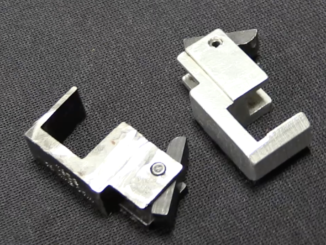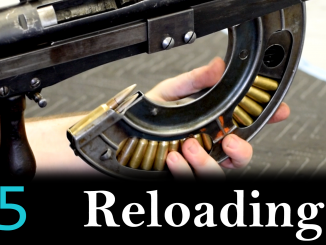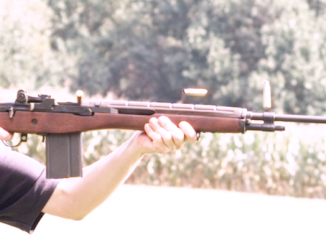The firm of Sedgley Inc of Philadelphia was a gun company involved in many aspects of the industry. They made rifle barrels for the US military, they made the rather goofy “Glove Guns” for the US Navy, and they did a lot of commercial gunsmithing, including high-quality sporter conversions of military surplus rifles.
This particular rifle is a .22 caliber Model 45 from Sedgley, which does not appear to have ever gone into mass production. It is interesting for it’s bolt mechanism, which is a typical semiauto blowback type. However, its handle allows it to be locked in the closed position for each shot, effectively turning the gun into a bolt action. It also has an uncommon style of safety, which is a lever that slides under the trigger to block its movement. Overall, a .22 with some interesting and rather uncommon features.




Maybe same rifle?
http://www.thefirearmsforum.com/threads/sedgley-22-rifle.3202/
Sounds like the same model – might be the exact same gun.
I love that safety, simple unobtrusive and quiet!
I can’t say anything about the Sedgley, but Walter made a 22 before the war that was very similar, the model 1 carbine. This is not a copy of that either, but I wonder if it was an attempt to make a cheaper gun that did the same thing.
Reminds another .22″ gun of later manufacture. French MAB Model F. It carries a lock lever on slide at left to block the breechbolt movement in case of using a muffler to obtain maximum silence free from action “Clank”.
The magazine looks like it might have come from a Remington 511 (started production 1939).
The Savage Model 6 (15-round tube magazine) and Model 7 (5-round detachable box magazine) had a mechanism very similar in concept to this. Both were semi-automatic straight blowbacks, with bolts that could be locked by pressing the bolt-retraction handle inward (to the left) to lock the bolt shut. Used this way, they could be operated as straight-pull bolt-actions, more-or-less like the Sedgely.
I noticed the unusual safety, very like that of some of the Volksturm rifles of the late war period. In fact, the entire mechanism reminds me very much of a typical German SMG design, like the MP.38/40, with the lock slots for the bolt-retraction handle. BTW, is it hammer-fired or does it have a spring-powered internal firing pin in the bolt itself?
I’m wondering if the reason the rifle didn’t go into production may have been a combination of the Savage rifles already being on the market, and possibly the Treasury Department getting nervous over a .22 rifle that could conceivably be easily converted to full-auto fire due to its very basic, “SMG-type” operating system.
cheers
eon
Did a little research on RF Sedgley. RF Sedgley himself passed away mid 1938, but obviously the company went on for some time after that. The company started out doing high grade sporterizing jobs on surplus arms, as well as limited production runs of special projects. If someone walked in the door with money, they’d make what they were asked to make–even gloves that went bang, as Ian showed.
If it was made in 1939 or thereafter (if the magazine was repurposed from a Remington 511, that would put it in that date range), then there were some things going against it. The founder of the company was no longer alive to guide the project. Non-sporting gun production basically ceased during WWII and then post-war the established gun companies turned from war production to producing sporting rifles. Remington had the model 241 and 550 22 semi-auto, Winchester had the model 74, and post-war Belgian Browning 22’s would have started coming over again. Converting surplus 03’s (presumably sold below cost) to sporting rifles to compete against Remington model 30’s would be one thing, while machining the rifle at hand from scratch to compete with a Remington 550 would be very much something else, and it would be hard to see the Sedgley being cost competitive in any way. It looks like an interesting design and to have been well executed, but may not have been enough to interest any distributors given the competition out there at the time.
the ideal system for switching: with subsonic ammo and an suppressor you use in bolt action mode and you don’t have the bolt making “clak!”
with normal ammo you use the semi auto mode.
The Weatherby Mk XXII (at least the ones made by Beretta, I’ve never looked at the later Japanese version) had a sorta”-manual” mode as well. There was a setting on the safety (mounted on the side of the receiver behind the bolt) that would hold the action open after each shot, and you rechambered by pushing the safety forward to close the bolt. Never saw much sense in it but it was an interesting feature.
Ian,
The bolt seems to have a pretty solid detent, but did you notice any mechanism to prevent the trigger or sear from moving when the bolt is between the semi and single positions? .22LR is little, yes, but I still wouldn’t want the thing to go off with incomplete engagement of the lug. It’s too bad you’re not allowed to pull these guns apart, but at the same time a great thanks to RIA for the access. And to you, as always, well done.
Thomas.
I have one of these 22 rifles, both bolt action and semi auto in near mint original condition, just wondered what it was worth?